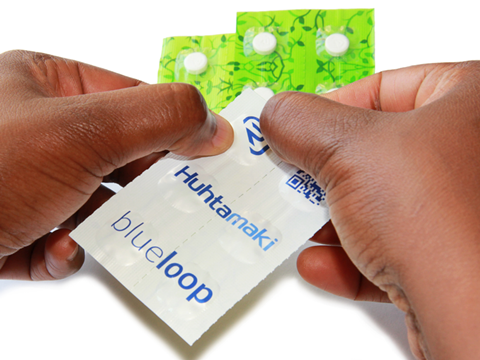
Our next 2020 Sustainability Awards finalist interview comes courtesy of Huhtamaki, who tells us more about its Push Tab loop solution – the first recyclable strip packaging for pharmaceutical solids.
Congratulations on being selected by the international judging panel as a Sustainability Awards 2020 finalist! Could you please introduce your successful entry and what’s innovative about it?
Huhtamaki presents the market’s first-ever recyclable unit dose packaging for pharmaceutical solid products called Push Tab®.
Push Tab adds a push-through function to strip packaging, creating an alternative for blister packaging. The material is completely without PVC and has significant benefits compared to traditional blister and coldform packaging. Since the relatively small cavities in Push Tab also mean smaller air pockets, the medicines have a longer shelf life.
As far as the eco-balance is concerned, the packaging forms in the Push Tab® product family have inherent additional advantages over conventional blister packs. This is due to the significantly lower material consumption, especially in direct comparison with Al/Al blisters. The Push Tab® foil exhibits the same barrier properties as blister foil but is much thinner and lighter.
With Push Tab® loop, the newest addition to the Push Tab family, Huhtamaki offers a recyclable tablet packaging solution, bringing tablet packaging closer to the circular economy.
What are the environmental challenges in packaging that your entry addresses, and what impact do you hope it will make?
Push Tab® loop is made from a polyolefin-based laminate which is seen as recyclable. More than 90 percent of the components which are used belong to the same material class (PE and PP). The result is a primary packaging recycling rate of better than 70% in an existing and proven recycling process. The barrier properties are not affected by the push through feature of the film and guarantee the highest levels of product safety.
Barrier wise, Push Tab® loop will provide the same barrier as PVC blisters. Currently, Push Tab loop with barrier is under development where we are aiming for a WVTR of 0,1 g/sqm/24h (38°C / 90%RH). The risk of migration is also very low, as an extrusion-laminated and coated laminate that doesn’t contain any solvents is used.
Different versions and forms ensure adequate market differentiation and are sustainable alternatives to blister or cold-form applications. Additionally, due to a significant reduction of the material consumption, Push Tab® loop offers cost-saving potential in comparison to blister and cold form.
I’d like to ask you about the broader picture beyond your successful entry. ‘Sustainability’ in packaging is multi-dimensional – both in terms of objectives and challenges. Could you comment on the most important roadblocks you identify from your position in the value chain, and the kinds of solutions you would like to see addressing them (e.g. areas of technological innovation, collaboration, regulation)?
To deliver innovations that drive sustainability and circularity, we believe that collaboration across the value chain, including consumers and policymakers, is key. Only together can we deliver a functioning circular economy. The value chain understands its consumers and their needs, and is great at delivering solutions. Policymakers can speed up the innovation process by ensuring the industry has the space to continue to innovate by using evidence-based policymaking.
Collaboration is also needed in removing some of the current roadblocks in waste management, for example by harmonising collection and recycling systems, in order to achieve a waste management and recycling superhighway for the 21st century.











